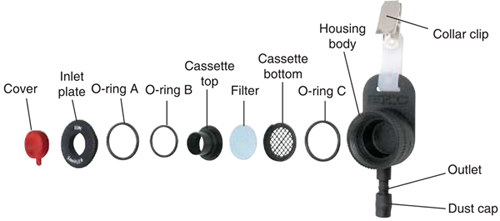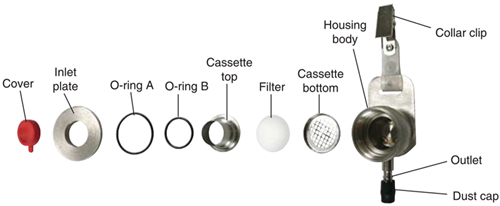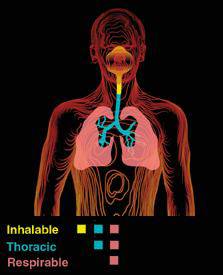IOM Sampler
The IOM Sampler, developed by J. H. Vincent and D. Mark at the Institute of Occupational Medicine (IOM) in Scotland, meets the ACGIH sampling criteria for inhalable particulate mass. The IOM Personal Inhalable Sampler is a conductive plastic sampling head that houses a reusable 25-mm filter cassette with specified filter for the collection of inhalable airborne particles. When attached to a personal sampling pump operating at 2 L/min and clipped near a worker’s breathing zone, the IOM effectively traps particles up to 100 µm in aerodynamic diameter and closely simulates how airborne workplace particles are inhaled through the nose and mouth. Because both the cassette and the filter are weighed as a single unit before and after sampling, all particles collected (even larger ones) are included in the analysis. The cassette can be cleaned, reloaded with a new filter, and reused.

Configuration for conductive plastic IOM Sampler and cassette - Cat. No. 225-70A and plastic IOM with stainless steel cassette - Cat. No. 225-79A

Configuration for stainless steel IOM Sampler and cassette - Cat. No. 225-76A
Particle Size-selective Dust Sampling
The hazard potential of airborne dust, solid particles, or droplets is dependent on the mass concentration as well as the particle size. Particle size determines the deposition site within the respiratory tract and the subsequent health effect. Therefore, the American Conference of Governmental Industrial Hygienists (ACGIH®) has recommended that particle-size selective Threshold Limit Values (TLV®s) be developed for inhalation hazards in the workplace.
Particle-size selective TLVs consider two points:
- The size-fraction most closely associated with the specific health effect
- The mass concentration within that size fraction which should represent the TLV
The ACGIH recommends that particle-size selective TLVs be expressed in threeforms:
 |
- Inhalable Particulate Mass
- Dust particles having a 50% cut-point of 100 µm. These dust particles are hazardous when deposited anywhere in the respiratory tract.
- Thoracic Particulate Mass
- Dust particles having a 50% cut-point of 10 µm. These dust particles are hazardous when deposited anywhere in the lung airways and gas-exchange regions.
- Respirable Particulate Mass
- Dust particles having a 50% cut-point of 4 µm. These dust particles are hazardous when deposited anywhere in the gas-exchange regions.
|
Since inhalable particulate mass is defined as those materials that are hazardous when deposited anywhere in the respiratory tract, including the nose and mouth, a sampler designed for the collection of inhalable dust should have a median cut-point of 100 µm.
References
Mark, D. and Vincent, J. H., "A New Personal Sampler for Airborne Total Dust in Workplaces," Ann. Occup. Hyg. Vol. 30,1986, pp. 89-102
ACGIH Technical Committee on Air Sampling Procedures: Particle Size-selective Sampling in the Workplace, ACGIH, Cincinnati, Ohio, 1984
Kenny, L.C., Bowry, A., Crook, B., and Stancliffe, J.D., “Field Testing of a Personal Size-selective Bioaerosol Sampler,” American Occupational Hygiene, Vol. 43, No. 6, 1999, pp. 393-404
Kenny, L.C., Stancliffe, J.D., Crook, B., Staff S., Griffiths, W.D., Stewart, I.W., and Futter, S.J., “The Adaptation of Existing Personal Inhalable Aerosol Samplers for Bioaerosol Sampling,” American Industrial Hygiene Association Journal, Vol. 59, 1998, pp. 831-841
Kenny, L.C., Chung, K.Y.K., and Dilworth, M., “Applications of Low-cost Multifraction Aerosol Samplers - Final Report,” IR/EXM/99/06, Health and Safety Laboratory, U.K., 1999
Kenny, L.C., Chung, K.Y.K., Dilworth, M., Hammond, C., Jones, J. Wynn, Shreeve, Z., and Winton, J., “Applications of Low-cost Dual-fraction Dust Samplers,” Ann. Occup. Hyg., Vol. 45, No. 1, 2001, pp. 35-42
Wang, C., et al., “Field Evaluation of Personal Sampling methods for Multiple Bioaerosols,” doi:10.1371/journal.pone.0120308






